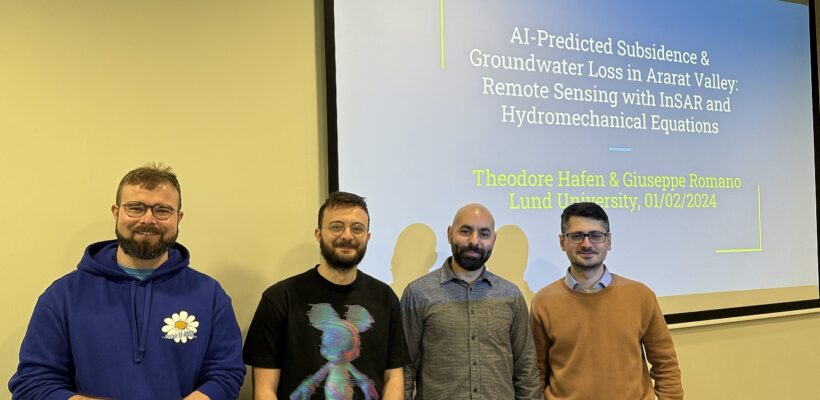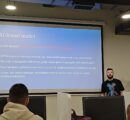
Lund University and AUA Acopian Center Collaborate on Ararat Valley Study
3 min readYEREVAN, Armenia — The American University of Armenia (AUA) Acopian Center for the Environment hosted two students from the Division of Water Resources Engineering of Lund University, Sweden. Giuseppe Romano and Théodore Hafen, two graduate students at Lund University, visited Armenia to conduct field research for their master’s theses on groundwater-driven land subsidence in the Ararat Valley.
Groundwater depletion in the Ararat Valley due to unsustainable levels of water abstraction for fish farming and agriculture has been well documented. The AUA Acopian Center’s collaboration with Lund University will study the impact of these high levels of water abstraction on land subsidence (sinking of land).
“While this is a known phenomenon throughout the world, it has not been studied in the context of the Ararat Valley,” states Dr. Garabet Kazanjian, assistant professor at AUA and freshwater ecologist at the AUA Acopian Center. “As groundwater is taken out, land tends to sink. The extent and type of sinking depends on the underground geology of the site,” he adds.
The research conducted by the students uses satellite imagery and the Interferometric Synthetic Aperture Radar (InSAR) technique to monitor land deformation (sinking) over time. The satellite images and InSAR analyses are supplemented with on-the-ground field data on groundwater levels, land elevation, and soil characteristics.
During their three-week stay in Armenia, Romano and Hafen met with representatives of the Hydrometeorology and Monitoring Center SNCO, Georisk CJS, and multiple experts from Yerevan State University and the Geology Institute of the National Academy of Sciences of the Republic of Armenia. They also presented their research proposals to two AUA undergraduate classes, one in computational science and the other in environmental science, generating active discussion with attending students.
For his thesis, Hafen plans to use hydrogeological data to study the long-term impact on the sustainability and volume of the groundwater aquifers in the Ararat Valley. “This will provide an estimation of what to expect in terms of storage loss in the Ararat Valleys’ aquifer based on what we know about the local geology, groundwater use, and impact of subsidence,” he explains. Meanwhile, Romano will use machine learning and artificial intelligence tools to forecast potential changes in groundwater reserves in the Ararat Valley based on various scenarios on the levels of water taken out from the Valley’s groundwater. Both students are expected to defend their dissertations in June 2024.
“Most of the groundwater resources in the Ararat Valley are of very high quality and could be used as drinking water with minimal treatment. It’s a national treasure but could also become a matter of national security, especially with the looming impacts of climate-driven changes in precipitation in our region. Developing the knowledge to assess and forecast its sustainability will help the nation engage in science-based decision-making regarding managing this resource,” notes Dr. Kazanjian.
The collaboration between the AUA Acopian Center and Lund University is supported by the Swedish Institute, which, within its broader mission of global outreach, facilitates cooperation between Swedish and non-Swedish researchers and universities. In February 2023, the AUA Acopian Center and Lund University’s Division of Water Resources Engineering signed a memorandum of understanding for joint research collaboration on the monitoring and management of water resources in both countries.
In June 2023, researchers from Lund University visited Armenia to initiate the 2-year collaboration. The visiting researchers included Professor Kenneth Persson, Associate Professor Hossein Hashemi, and researcher Christian Alsterberg. The video recording of their public talk at AUA on the “Latest Trends and Methods in Water Research” is available here.
Drs. Persson and Hashemi are also supervising the two Lund students working on groundwater monitoring of the Ararat Valley. Dr. Kazanjian and other Armenian researchers are slated to travel to Lund University in June this year.
The AUA Acopian Center for the Environment, a research center of the American University of Armenia (AUA), promotes the protection and restoration of the natural environment through research, education, and community outreach. The AUA Acopian Center’s focus areas include sustainable natural resource management, biodiversity protection and conservation, greening the built environment, sustainable energy, as well as information technology and the environment. Visit http://ace.aua.am.


